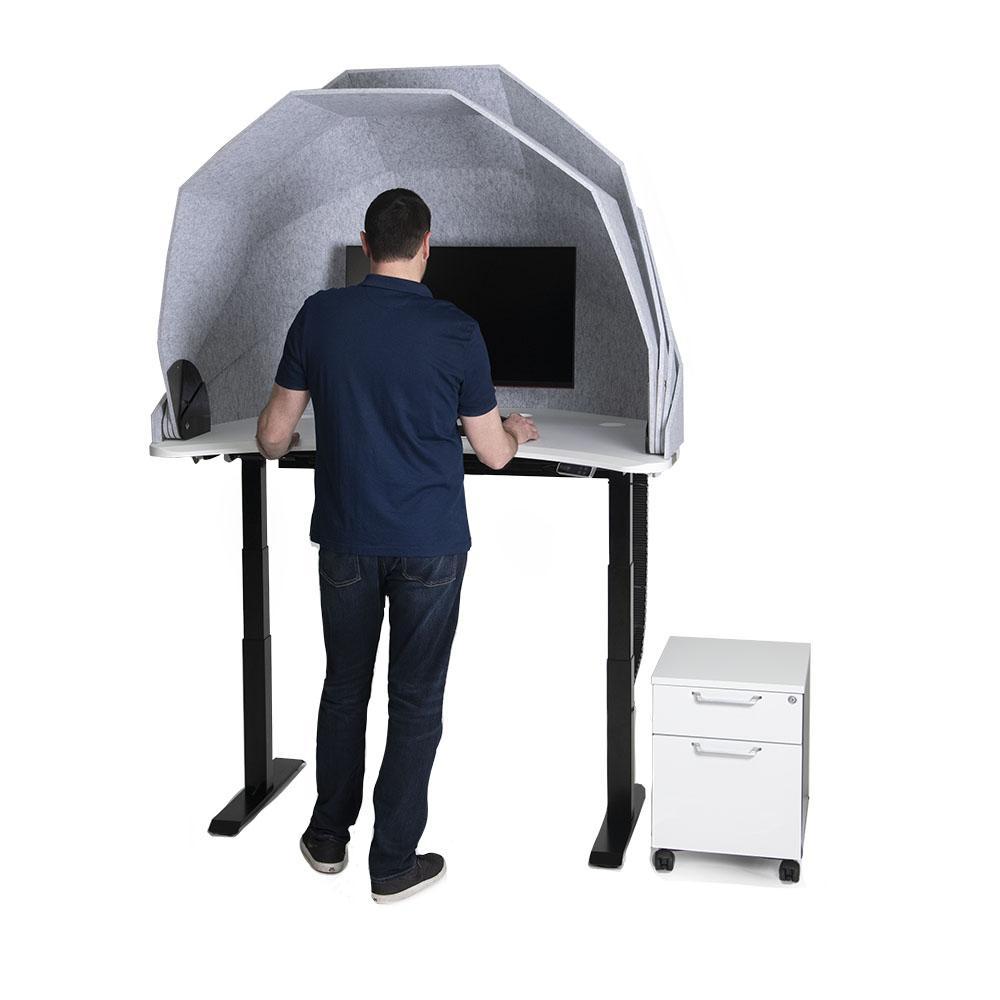
Ever since the open workspace trend burst onto the corporate scene a couple of decades ago, workers and managers alike have regarded open design with skepticism. Exactly how productive can an employee be in the physical midst of other humans, with their sounds, movements, smells, and more. Ever worked in an office with Tuna Sandwich girl? Or Fish Friday guy?
Add the new threat of coronavirus germs that threaten the confidence and the health of employees, and it’s a wonder any work is getting done at the office.
The answer may seem obvious: have everyone work from home. But there are, simply, some businesses who cannot work from home, for reasons ranging from access to needed technology to security concerns. Even the techiest of tech companies, e.g., Apple, are bringing employees back to the office for reasons ranging from hardware access to data security threats, which increase exponentially for work-from-home employees.
For companies that will not allow work from home, and don’t have the option of exiting their office lease for a better “social distancing” layout, here are three ways to improve productivity in the open workspace:
Emotional Obstacles to Productivity
Until now, the emotional impact of working in the open workspace has been the “elephant in the room.” As Forbes reports, working in an open office already lowers employees' output as well as their morale. Today (thank you, coronavirus), more data than ever before is available before to show the cost of feeling insecure about work when it comes to one’s health and safety.

A new study by Ginger, an on-demand mental health company found that nearly 70 percent of workers claim that this is the most stressful time of their careers, exceeding their stress levels in the time of the September 11 attack and the 2008 Great Recession.
Options for making employees feel safe at work include:
1. Rigid Health Monitoring
Conducting regular temperatures checks, reporting of symptoms, upgraded office cleaning, and handwashing protocols lets employees know you're serious.
2. Virtual Mental Health Services
Leaders beyond the HR department are now leaning into the need to offer mental health support to employees. Telehealth is playing a critical role in enabling the privacy and convenience issues that have blocked stress out employees from seeking help in the past.
3. Visible Safety
These include tangible measures like social distancing barriers, re-design of office space for six-foot social distancing, and office furniture upgrades like MojoDome.
Audio Disruptions in the Open Workspace
Ever been on the receiving end of a call from a noisy call center? Few things are more annoying and distracting. Imagine the person who is trying to help you upgrade your insurance policy, sell you a piece of technology, or provide technical support.
Whatever the scenario, rest assured that both the employee and the customers are having a less-than-pleasant interaction, and that impacts productivity.
Research from global market research firm IPSOS found that 95 percent of audio end-users and decision-makers experience pain points relating to sound that affect their concentration or efficiency at work. These pain points include background noise, having to repeat yourself, and asking for information to be repeated. For businesses that lack access to high-quality audio technology, audio pain points cost companies dearly in terms of time, productivity and revenue.
SOLUTIONS:
1. Employer-provided technology
Having a quality microphone is essential for making or receiving professional phone calls or video conferences. Upgrading to a USB microphone like Blue Microphone is a massive upgrade to sound quality for not a huge investment, vs. your iPhone headphones or built-in computer microphone.
2. Smaller groups of employees in the office at a time
While this isn’t exactly helpful for making up lost revenue caused by COVID-19, more and more companies are splitting shifts or otherwise reducing by 50 percent the number of employees who can be in the office at a single time.
3. Soundproof Booths
Office products with names like privacy pods and phone booths have tried, with mixed success, to address the privacy issue in the open workspace. Options up till now haven’t been great, but stay tuned for convertible, sound-absorbing options.
Visual Distractions
“Visual noise” can be caused by things like bright walls, busy pictures, knickknacks, or clutter on your co-workers’ desks, even your co-workers themselves. The biggest cause of visual noise? Movement of people.
While being around teammates who are performing similar tasks can be a comfort to some workers, it's true that unpredictable movements around one's field of vision distract our brains from the task at hand. People vary in their responses to visual distractions, and being visible to bosses and colleagues can make workers feel pressured to conform to others’ expectations. For employees who default to keeping their heads down to look busy, rather than taking time to reflect or confer with others, innovation and analytical work can suffer.
SOLUTIONS:
Cubicles
The old-school solution to physical distraction was the cubicle, which eventually became a joke to many, as cartoons like Dilbert and TV shows like "The Office" poked fun. Plus, a cubicle doesn’t solve the other issues of sound and safe social distancing.
Redesign
Some workspaces are set up like a warehouse, creating long lines of sight where employees see everything that's happening around them. If your business has the option, change the setup to be more of a labyrinth, with walls, corners, short hallways, and large plants that block views between co-workers.
MojoDome: an adjustable Privacy Pod and Sit-Stand Desk
Much like blinders on a horse, the MojoDome is a convertible workstation allows workers to raise and lower their personal office "walls" around them, as needed and on-demand.
Are you transitioning your team back to the open workspace? Then check out MojoDome.




